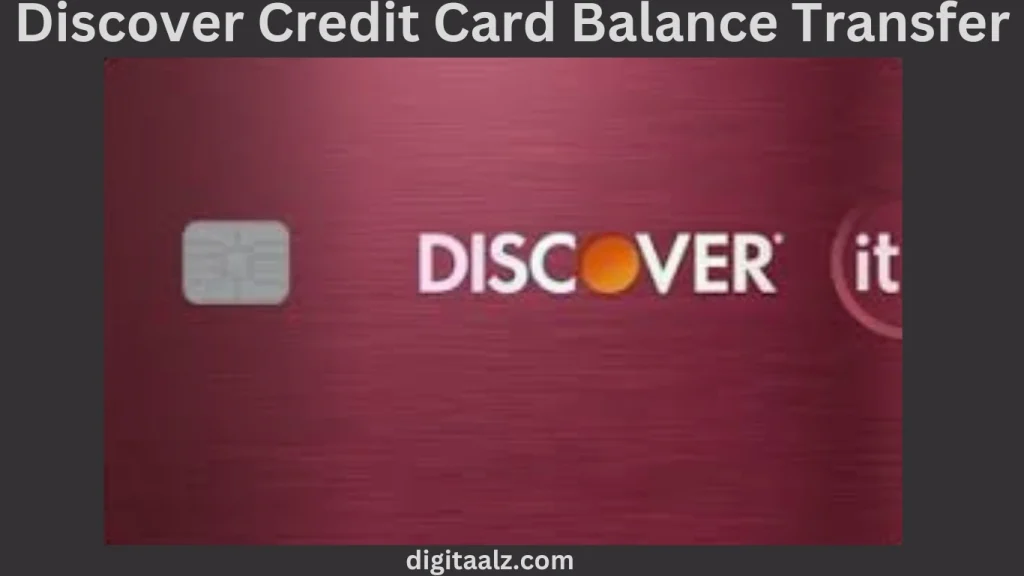Managing debt can be stressful, especially when high interest rates keep your credit card balance growing month after month. Many people struggle to pay off their credit cards because interest piles up fast. One popular solution is a Discover credit card balance transfer, which gives you a chance to move that debt to a new card with a lower interest rate often 0% APR for a limited time.
In this article, we’ll break down everything you need to know about how it works, what it costs, how to apply, and whether it’s the right move for your financial situation.
What Is a Balance Transfer?
A balance transfer means taking the money you owe on one credit card and moving it to another credit card, often one that offers a lower interest rate. People use this to avoid paying high interest and to consolidate debt into a single monthly payment. It’s like giving your wallet a break from constant interest charges.
When you do a Discover credit card balance transfer, you’re choosing to work with a well-known and trusted credit card company. Discover offers competitive promotional APR deals that can make a big difference in how fast you can pay down your debt.
How Discover Balance Transfers Work?
A Discover credit card balance transfer starts by applying for a Discover card that has a promotional balance transfer offer. Once approved, you can ask Discover to pay off the balance from another card (not another Discover card). They’ll then add that amount to your Discover card, and you’ll repay it over time—hopefully during the period when interest is at 0%.
Here’s how it usually works:
- You apply for a Discover credit card.
- You’re approved and receive a balance transfer offer.
- You choose which card’s balance to transfer.
- Discover processes the transfer and pays the amount.
- You repay Discover under new terms, ideally with 0% APR.
If you complete the transfer early in the promo period, you get the full benefit of the low-interest or no-interest period. But if you wait, you’ll have less time to pay it off without interest.
Features of Discover Balance Transfers
To understand whether it fits your needs, let’s look at the features Discover usually offers with its balance transfer cards.
| Feature | Details |
| Introductory APR | 0% for up to 15–18 months (varies by offer) |
| Balance Transfer Fee | Usually 3% of the transfer amount |
| Standard APR After Intro | 18.24% to 28.24%, depending on your credit score |
| Annual Fee | $0 – no cost to keep the card open |
| Processing Time | 7 to 14 business days after request (and card activation) |
| Minimum Credit Score Needed | Typically good to excellent (670 or higher) |
| Cashback or Rewards | Some cards offer cashback even after using for a balance transfer |
These features make a Discover credit card balance transfer attractive for people who are trying to get out of debt and need a break from high interest.

How to Do a Discover Balance Transfer Step-by-Step?
Applying for and completing a balance transfer with Discover is pretty simple. Still, there are steps you need to follow carefully.
Step 1: Choose the Right Discover Card
Not every Discover card offers the same balance transfer deal. You should look for a card with 0% APR for as many months as possible and a low balance transfer fee. The most popular option is the Discover it® Balance Transfer card, which typically offers a generous 0% intro APR period.
Step 2: Apply and Get Approved
Once you apply online, Discover will check your credit report. If you have a solid credit history, approval usually takes just a few minutes. If approved, you’ll receive your card in the mail.
Step 3: Initiate the Balance Transfer
Once you receive the card and activate it, you can log in to your account and request a balance transfer. You’ll need:
- The account number of the old credit card
- The amount you want to transfer
You can’t transfer a balance from another Discover card. Only third-party card balances are eligible.
Step 4: Wait for Processing
The processing usually takes 7–14 days. You must continue making payments to your old credit card during this time. If the transfer isn’t completed before your next due date, you might be charged a late fee by the old creditor.
Step 5: Pay Off the Transferred Balance
Once the transfer is complete, you’ll see the new balance added to your Discover account. If you pay it off within the promotional 0% APR window, you’ll avoid interest completely. That’s the main benefit of using a Discover credit card balance transfer.
Real Example: How Much You Can Save?
Let’s say you owe $5,000 on a card with 22% interest. That could cost you over $1,100 in interest in one year if you just pay the minimum.
But if you transfer the balance to a Discover card with 0% APR for 15 months and pay $334 per month, you can pay it off before the promo ends—and pay $0 in interest.
Here’s how the savings look:
| Item | High-Interest Card | Discover Balance Transfer |
| Balance | $5,000 | $5,000 |
| Interest Rate | 22% | 0% (15 months) |
| Interest Paid (15 months) | ~$1,100 | $0 |
| Monthly Payment | $200 | $334 |
| Time to Pay Off | Over 3 years | 15 months |
As you can see, a Discover credit card balance transfer could help you get debt-free faster and save you a lot of money.
Is It Worth Doing?
They offer a smart way to escape high interest, but it’s not right for everyone.
If you can pay off your debt during the intro period and avoid adding new purchases, it’s a powerful tool. But if you continue to spend or can’t pay off the balance before the promo ends, you’ll just be moving the problem—not solving it.
Make sure you understand the transfer fees, the time frame, and the fine print.
Tips for Success with a Discover Balance Transfer
- Start early: Don’t wait too long after opening the card. The clock on the 0% APR starts soon after the account is approved.
- Avoid new purchases: Focus on paying off the balance instead of adding more to your card.
- Set up auto-pay: This ensures you never miss a payment and avoid late fees that could cancel your intro APR.
- Watch your limits: You can’t transfer more than your credit limit allows. Leave room for the balance transfer fee.
Frequently Asked Questions
Can I do more than one balance transfer?
Yes, you can request multiple transfers as long as you don’t go over your available credit limit.
Do I need to pay the balance transfer fee upfront?
No, the fee is added to your card’s balance. You’ll pay it off over time with your monthly payments.
Does a balance transfer hurt my credit score?
It might cause a slight dip due to the credit inquiry, but over time, your score could improve if your credit utilization drops.
What happens if I don’t pay off the balance in time?
If you don’t finish paying by the end of the promo period, you’ll be charged the regular APR on the remaining balance.
Can I cancel the transfer after requesting it?
No, once submitted, the transfer is usually final. Make sure you’re sure before completing the request.
Conclusion
A Discover credit card balance transfer is a smart choice for many people trying to escape the trap of high-interest debt. It gives you a window of 0% interest, usually for up to 15 or even 18 months, to focus on paying off your balance. It also offers the convenience of combining several debts into one simple payment.
They are especially useful if you have good credit and a solid plan to repay the transferred balance before the promotional APR ends. With no annual fee, reliable service, and strong promotional offers, Discover makes it easier to take control of your finances.
As long as you’re disciplined, avoid late payments, and don’t rack up new debt, a Discover card can help you move one step closer to being debt-free.
Also, Read Can You Pay Affirm With A Credit Card?
